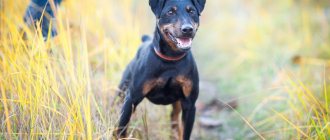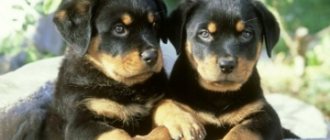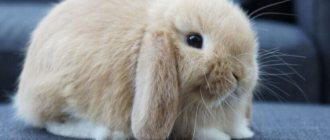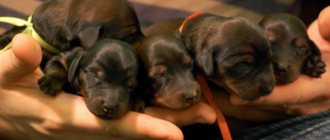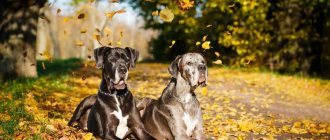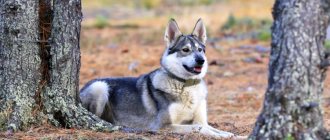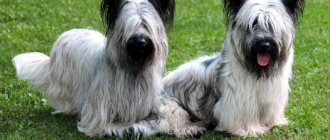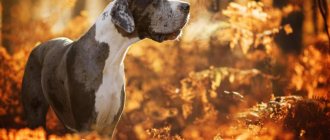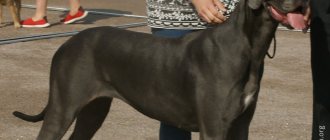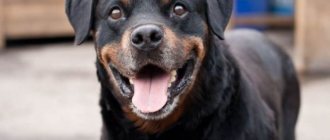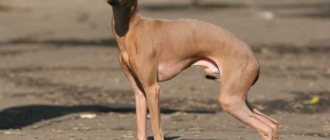Jagdterrier puppies are very amazing, cute and playful animals. In general, this dog breed is considered relatively young. She was bred about 50-60 years ago. Now there are 2 types of dogs within this breed - long-haired and smooth-haired. Dogs of this breed are considered very hardy and have good health. They are distinguished not only by good strength indicators, but also by resistance to various diseases.
Jagdterrier puppies are very amazing, cute and playful animals.
Breed characteristics
| Short description | |
| Origin: | Germany |
| Conditions of detention: | Country house with a large plot, apartment |
| Purpose: | Hunter |
| Color: | Black or brown and tan |
| Wool length: | 2 – 4 cm |
| Adult dog size: | Height 34 – 39 cm, weight 8 – 10 kg |
| Average life expectancy: | 13 – 15 years |
| Walk: | Mandatory, daily |
| Physical activity needs: | High, from 3 hours a day |
| Fédération Cynologique Internationale (FIC) classification: | Group 3, section 1 |
| Puppy price: | From 5,000 to 35,000 rubles |
German Jagd Terrier price
Club German Jagd Terrier puppies from parents with working diplomas and a package of documents will cost 15,000 - 20,000 rubles. If field trials and going to exhibitions are not planned, you can turn to familiar hunters who periodically mate their charges. Such berries cost much less, around 5000-8000 rubles, but in terms of working qualities they are not inferior to offspring from champion producers. The only caveat: puppies from a non-professional breeder may not have puppy metrics, which casts doubt on the purity of the litter.
History of the origin of the species
The history of the breed is not shrouded in myths and legends, due to the relative youth of the species - Jagdterriers trace their gene pool from fox terriers rejected for color. In the 20s of the 20th century, exhibitions became fashionable, and the selection of fox terriers was aimed at the exterior, which significantly reduced the working qualities of the dogs. Walter Zangenberg, a hunter and owner of fox terriers, was disappointed with the new characteristics of the breed, and was inspired by the idea of breeding a new species - ideal for hunting.
To the defective fox terriers, Walter mixed the genetic codes of English wire-haired terriers, Welsh terriers and other dogs with first-class working qualities, relegating appearance to the background. In just 10 years, Zangenberg managed to get two hundred black and tan dogs of the same type, which he named German Jagdterrier . But the International Canine Federation accepted the breed only in 1954.
Character of the German Jagd Terrier
It is important to understand that the German Jagd Terrier does not exist outside of hunting, so buying a dog for yourself, children, or “for the sofa” and expecting aristocratic manners from it is not the most logical thing to do. However, even a yagd who regularly goes into the forest and works on animals is still obstinate. So say goodbye to the dream of making your pet an obedient “deliver” of slippers - this breed loves to cooperate, but not to serve and fawn.
The one who stole my heart
It is believed that professional training and early education can dampen the aggression and stubbornness of German Jagd Terriers, but there are also nuances here. Yes, a dog can be weaned from the habit of attacking strangers, but even an experienced dog handler will not be able to make him fall in love with a cat or another pet furry dog. Berries also attack small wild animals. For example, in rural areas, one of the main victims of the breed are hedgehogs. The black-and-tan “gladiators” are not stopped by either needles or the injuries they cause - reprisals against the prickly enemy are carried out immediately and to the bitter end.
It's the same story with unfamiliar dogs. German Jagdterriers have a strategic reserve of courage and the same amount of recklessness, therefore they are capable of provoking a conflict with their fellow tribesmen without any reason. The breed also has no time to understand the hierarchical system of the canine world, so even Yagd puppies easily go to extremes, such as encroaching on someone else’s bone or furiously attacking an adult wolfhound. Moreover, the larger the opponent, the more chances he has to infuriate the terrier - the impressive size of the opponent evokes a mixture of black envy and hatred among the “Germans”.
In a relationship with a person, Yagd prefers not to be scattered, but to concentrate on one person. Usually this is the one with whom the animal goes baiting and hunting. The dog recognizes the rest of the family members insofar as it is not in a hurry to fulfill their demands. The companion qualities of the breed are also tied to working instincts. The Jagdterrier will behave obediently during a walk only if there is someone nearby under whose leadership the animal is accustomed to hunting game. With all other household members, “feedback” will be episodic, so you can let your ward off the leash in the park in one and only case - if this park belongs specifically to you and there is not a single representative of wild fauna in it.
Distinctive features
Description of the German Jagdterrier breed:
- General form. A strong, compact dog with a slightly stretched format.
- Height. At the withers, males have 34–40 cm, females 33–39 cm, weight 8–10 kg and 7–9 kg, respectively.
- Head. Small, wedge-shaped, tapering towards the nose. The occipital protuberance and the transition from the forehead to the muzzle are poorly defined. The eyes are symmetrically located, the shape is close to almond-shaped, brown or dark brown in color. The ears are small, triangular with a crease in the cartilage, set high and close to each other.
- Muzzle. Narrow, nose black or brown, lips tightly fitting. Scissor bite, jaws strong, teeth tightly clenched.
- Neck. Dry, without dewlap, with pronounced muscles.
- Frame. Compact but muscular, lacking dampness. The stomach is tucked in, the back is straight and strong. The ribs protrude slightly, the chest is moderately wide, descending to the level of the elbows.
- Limbs. Straight, parallel, fingers closed. The thighs are strong, muscular, the hock joints are well defined.
- Tail. It is docked and 2/3 is left. Set on moderately, in an excited state the dog holds it above the level of the back.
- Coat and color. The coat is thick and dense, in two variations - wire-haired and smooth-haired. There is very little undercoat. Colors are black or brown and tan.
Sexual dimorphism is moderately expressed and is welcomed in exterior assessment.
Breed standard German Jagd Terrier
German Jagd Terrier puppy
Like a real hard worker, not used to lying on the sofa and posing for the camera, the Jagdterrier cannot boast of either a stylish satin “fur coat” or a particularly sweet appearance. However, he doesn’t need this, since the vast majority of owners of the breed are practical people who demand professional skills and an exciting hunting show from their pet, but are absolutely indifferent to the exterior of their ward. Accordingly, the correct German Jagdterrier is first a hardy and strong breadwinner, and only then a friend, companion and everything else.
The standard height of a yagda ranges from 33-40 cm, and these figures apply equally to both females and males. But the weight categories of dogs of different sexes are different. Female jags weigh from 7.5 to 8.5 kg, while males are able to build more voluminous muscle mass, maintaining a weight between 9 and 10 kg.
Head
The head of the German Jagd Terrier appears moderately elongated with clearly defined cheekbones and a developed chin. The skull is flattened, quite spacious in the area between the ears. The muzzle is shorter than the head, without strong pointedness, with a slight stop.
Jaws, lips, teeth
Representatives of the breed have massive jaws, closed in a complete scissor bite, hidden by brightly pigmented dense lips. The teeth are large, set evenly, in the amount of 42 pieces.
Nose
Dimensions of the German Jagd Terrier
The dogs have a harmoniously developed, small nose, predominantly black in color. A brown tint is acceptable for individuals with the same coat tone.
Eyes
The German Jagdterrier is a dog with a determined, direct look. The animal's eyes are small, oval, located at a distance from each other, which minimizes the risk of damage from the paws of forest predators.
Ears
The ear flap of a purebred Jagda is set high, has medium dimensions and a regular triangular shape.
Neck
According to the FCI standard, animals must have strong necks of normal length, gradually turning into shoulders.
Muzzle of a German Jagdterrier
Body
The German Jagd Terrier is a compact breed. Mandatory condition: the girth of the dog’s sternum should be 10-12 cm greater than its height at the withers. The body length also exceeds the height at the withers, but only slightly. The top of the body is straight, with a muscular loin and an impressive horizontal croup. The animal's chest should be deep, with arched ribs laid back. The line of a slightly tucked belly, which has a graceful curve, looks very elegant.
Limbs
King of the Hill
A prerequisite for the legs of a German Jagd Terrier is that they are parallel to each other when viewed from the front and rear. In addition, the limbs must have strong bones and dry muscles. The shoulder blades are elongated, oblique, with developed muscles. The elbows are located close to the body without obvious turning in any direction. The forearms are steep and straight.
The dog's hind legs look more substantial due to the elongated, moderately wide hips. Elongated sinewy shins, short vertical metatarsals and strong hocks are responsible for the springy push in movement. The round-oval paws of the yagda are “reinforced” with hard, intensely pigmented pads, and the front paws are noticeably larger than the hind paws. When standing and walking, the paws should not turn inward (clubfoot) or outward.
Tail
Jagdterriers living in countries where docking is prohibited have long, straight or saber-shaped tails. Such a tail is carried horizontally or barely raised at the top. Working dogs in Russia have their tail docked at ⅓. In this case, it takes a slightly raised, but not vertical position. In addition, the tip of the last vertebra should not deviate towards the back, since in burrow hunting conditions the tail plays the role of a “handle”, by which the owner can pull an angry dog out of an underground tunnel.
Wool
German Jagd Terriers come in two varieties: wire-haired and smooth-haired. In both cases, the outer hair has a coarse, dense structure, which helps the dog not get wet in rainy weather and protects the body from mechanical damage during hunting.
Color
Today's German Jagd Terrier is a brown, black, or grayish-black dog with tan markings on the chest, legs, muzzle, under the tail, and on the eyebrows. Acceptable features: the presence of dark and light masks on the face, the presence of tiny white spots on the toes and chest.
Brown Jagdterrier
Disadvantages and disqualifying vices
External features that do not fit into the parameters specified by the standard are positioned as exterior defects. There can be many such shortcomings, ranging from an overly pointed muzzle to splayed toes. If an animal is found to have behavioral and developmental defects that cover its breed qualities, this is almost always disqualification from the exhibition. The most common disqualifying defects of Jagd Terriers:
- different eyes, iris blue or speckled;
- malocclusions, including misalignment of the jaws and incorrectly positioned incisors;
- incomplete dental formula (the absence of M3 does not count);
- inversion or inversion of the eyelid;
- non-standard pigmentation of the earlobes, lips, paw pads;
- too tall or short;
- weak character, fear of shots and wild animals.
Photo of an adult dog
Pet training
During training you need to be firm, demanding and consistent. But excesses are also not necessary, since the Jagdterrier simply will not obey a fussy, nervous, overly weak or, conversely, tough person.
In order for a pet to receive the highest score in tests, it must have a death grip on the throat, cheeks, and back of the head - the location depends on the type of animal. Moreover, the grip should be long. Despite the size of the animal with which the Jagdterrier enters into battle, he holds it with a death grip. Half of the dogs of this breed do this. You can only open your jaws with a shovel. But the other half prefers to exhaust the beast with constant attacks on its pressure points and driving it out of its holes. Moreover, Jagdterriers are not taught this - they have innate characteristics. They are brave and determined fighters from birth, so not every person has enough experience and perseverance to raise a worthy dog.
Photos of puppies
Character and behavior
The full character of this breed can only be revealed during a hunt; in everyday conditions, Jagd Terriers are unbalanced and stubborn.
Normal conditions of coexistence for this dog:
- constant movement;
- search and pursuit of prey;
- attached only to the owner, can dominate over other family members.
Important. With constant physical activity and proper training, Jagd Terriers are ideally obedient and restrained when communicating with strangers or representatives of the fauna.
The dog can play with children, but does not tolerate excessive affection, has high intelligence and is easy to train at an early age.
The dog's temperament is hyperactive, so it cannot be locked up for a long time - it needs constant movement and space, so the pet needs to be walked 2 times a day for at least 2 hours.
When walking in the city, a leash is required, otherwise the pet may be carried away by the excitement of the hunt, then it will no longer listen to any shouts or orders, but will pursue the prey to the end.
This breed can coexist with other pets (except rodents); Jagdterriers need to be accustomed to neighbors gradually.
Expert opinion
Leonid Rodin
Experienced dog breeder
Ask a Question
The Jagdterrier has a very specific character. His stubbornness knows no bounds, and his desire to chase game prevails over all other desires. Therefore, a person who does not have experience with hunting dogs and lives in the city should not own a small German terrier. In the absence of a full-fledged hunt, the Jagdterrier will tirelessly chase cats. Moreover, the victim will not be able to hide on low trees. The dog, as a rule, is so carried away by the process that it begins to jump on the trunk and is even able to climb it to a small height. German Terriers make good watchdogs. They love the sound of their own barking so much that they can bark nonstop. You can't expect protective skills from a hunting dog. The Jagdterrier is not able to do anything other than warn the owner about the approach of a stranger, and the terrier will not engage in a fight with him or use his teeth.
Smooth-haired Jagdterrier photo
History of the breed
Developed in Germany at the beginning of the 20th century, this breed is the result of crossing fox terriers, small German hounds, dachshunds and pinschers. The purpose of such crossing is to obtain a dark-colored dog that will adapt well to any conditions, withstand heavy loads and be ideal for hunting.
Jagdterriers have always been very popular in their homeland and in Austria. In the CIS countries, this breed appeared at the end of the twentieth century.
Did you know? Trying to achieve a dark color for the breed, breeders have ruthlessly culled many animals, since it is believed that
light-colored “helpers” bring bad luck when hunting and can scare away prey.
Features of behavior
As befits a real hunter, the Jagdterrier is distinguished by exceptional energy. This is a dog who never sits still. And if the energy is not directed in a peaceful direction, the child begins to look for things to do on his own - chewing furniture, digging holes, chasing cats. It is absolutely not suitable for lazy and melancholy people, but in hunting or sports the breed has no equal.
To this day, the Jagdterrier has retained amazing working qualities. This dog has an excellent sense of smell, endurance and a desire to work, thanks to which the breed is gradually moving from a burrow hunter into the category of universal hunters. Yagi are capable of hunting small burrow predators, swamp and steppe game, and ungulates with equal success.
The German Hunting Terrier cannot be called a dog with high communication skills. The breed does not get along well with other animals (especially rodents or birds); due to its innate leadership qualities, the dog can start fights on the street with other dogs. Treats strangers with caution, but without excessive aggression. Although with a good level of early socialization this deficiency can be reduced, it cannot be completely eradicated.
Another feature of the breed is courage, absolute and sometimes reckless. When going out to fight a predator, or defending a dog’s owner, the instinct of self-preservation is completely turned off. Which is fraught with injury, since the Jagdterrier’s opponent’s size never stops him; he is ready to fight to the death with anyone.
The breed is not suitable for novice dog breeders; it has a complex character. During educational processes, a poorly motivated child often displays remarkable stubbornness and self-will. And with harsh correction methods, he may snap back. Hunting breeds that do not know how to show independence in real hunting conditions are doomed to death; in Jagdterriers it is this trait that complicates the educational process.
Advantages
The German Hunting Terrier has a lot of advantages:
- Intelligence and quick reaction;
- Irrepressible energy;
- Strength and endurance;
- Good hunting instinct;
- Excellent hearing and sense of smell;
- Courage;
- Ability to make independent decisions;
- Compact dimensions;
- Easy to care for;
- Good health;
- Good security qualities;
- Unpretentiousness in content.
All the advantages of this little dog cannot be included in one list.
Flaws
Of course, despite all the advantages of the breed, there are also disadvantages:
- Poor level of communication;
- Hyperactivity;
- Lack of self-preservation instinct;
- Difficulty in training;
- Stubbornness;
- Frequent injuries.
Unbridled energy, splashing from a small body, from an advantage, easily turns into a disadvantage, if the content is inappropriate for this breed.
Education and training
The German Jagdterrier is a breed that needs to be raised “yesterday.” It is recommended to use traditional methods, but with an eye on the yagds’ tendency to dominate, which is expressed in biting family members, suppressing other animals, and attacking random passers-by. So, in the process of training, do not forget to instill in the dog respect for yourself and your household, showing it that the boss’s chair has been occupied for a long time.
Gentleman on a walk
Intellectually, the Yagdas may not be geniuses, but they are quite smart comrades, so they do not have any difficulties remembering commands. At the same time, perfect adherence to the “charter” is not their strong point. As an example: it is possible to train a German Jagd Terrier OKD in six months, but it is pointless to demand from him the endurance and diligence of a German Shepherd. Moreover, you should be lenient towards your pet’s mistakes: after all, you chose the ideal hunter, not a circus performer and watchman. However, you shouldn’t condone it either. Basic OKD commands will later come in handy when hunting, since they can be used to control the dog’s behavior.
The critical age for representatives of the breed is 6 months. It is during this period that the German Jagd Terrier begins to test the owner’s patience with renewed energy. There is no need to cancel the training of angry teenagers, but if there is a lack of personal experience, it is better to involve a professional. An obligatory part of the program in raising and training a Jagd Terrier is accustoming to a collar, leash and muzzle. The breed does not favor the latter accessory, but without it it is dangerous to let the four-legged rogue out into the street if you do not want to later save stray cats and conflict with passers-by who are shocked by the Yagda’s attacks.
Approach the process of putting on a muzzle carefully, without haste. Experts recommend first letting your dog sniff the device, and also placing your pet’s favorite treat inside the mesh. Time should also be allowed to get used to the muzzle. In the first days, 2-3 minutes of wearing the restraint will be enough, then the duration of use can be increased to half an hour or more.
Care and maintenance
The ideal housing option for a German Hunting Terrier is a country house with a large and securely fenced area. But a spacious area for a splash of energy does not mean that you don’t have to exercise your dog; out of boredom, the dog will dig holes and gnaw trees and bushes on the site. Having your own reservation does not eliminate the need to walk and socialize the yagda.
The compact dimensions of the breed allow you to keep the yagda in an apartment, but subject to daily active walking for at least 3 hours a day.
Otherwise, caring for a Jagdterrier is not a hassle:
- Clean your ears from dirt once every two weeks;
- Brush your teeth once a month;
- Carry out a preventive dental examination at the veterinarian twice a year;
- Once a week, wipe your eyes with a special lotion;
- Carry out preventive deworming once a trimester;
- Vaccinate against infectious diseases once a year;
- As necessary, carry out ectoparasite prevention.
In fact, this is a minimum set of procedures for caring for a dog.
Nutrition
The recommended feeding regimen for dogs is presented in the table:
| Age | Mode |
| 1 – 3 months | Fractional feeding in small portions every 3 hours 6 – 7 times a day |
| 3-5 months | 5 times a day |
| 5 – 7 months | 4 times a day |
| 7 – 11 months | 3 times per day |
| 11 or more months | It is acceptable to switch to the adult dog’s regimen – 2 feedings per day |
As for the diet, the choice is up to the owner - Jagdterriers are healthy dogs, the owner’s task is only to maintain the animal’s condition with decent nutrition.
Dry food of good quality costs a lot of money, but decent feeding with natural products takes a lot of time, and financially it doesn’t work out much cheaper.
Authorized products:
- Meat (any except fatty variations - lamb and pork) and offal (any except kidneys and liver). Should form the basis of the diet. A carnivore does not need to cook meat.
- Fish. Any varieties of white sea fish without bones, it is enough to give once a week.
- Fermented milk. With fat content no higher than 5%.
- Eggs. Only the white is better; boiled yolks have a lot of sugar.
- Cereals. The source of complex carbohydrates is oatmeal and rice, but no more than 10% of the total diet; the dog will not receive anything useful except excess weight if there is an excess of cereals.
- Cartilage and tendons. Also in raw form, very rich in protein.
- Vegetables and unsweetened fruits. Only in fresh form, otherwise they have no vitamin value.
Prohibited Products:
- Sweets, including sweet fruits (such as grapes)
- Flour products. With the exception of dried rye bread.
- Sausages and smoked meats.
- Salt and spices are also not needed by the predator.
- Marinades.
- Sharp or tubular bones.
All these products can cause acute and chronic diseases of the stomach, pancreas or injure the esophagus. And cereals such as millet, semolina, and pearl barley are not digestible in the dog’s body.
We recommend that you read a detailed article on the topic: “How and what to feed a dog: types and characteristics of nutrition.”
Health
Breeders, when breeding the breed, tried to avoid common genetic diseases - successfully . Today, breeders actively continue to work to maintain the state of the gene pool in the same form. Sick individuals (both physically and mentally) are completely excluded from breeding. Thanks to this, with proper care, Jagdterriers can easily live up to 14 - 15 years , without age-related or breed-related ailments.
The only problem that the owner of a jagda may encounter is injuries received in fights with wild or other domestic animals.
Vaccinations
- The first veterinary procedures must be carried out by the breeder - at about 6 weeks, prevent helminths for the entire litter, and after 2 weeks, double deworming.
- By the 10th week of life (no later), the owner must provide a vaccine against a minimum set of viral infections - enteritis, Carré's disease and viral hepatitis.
- Additionally, your veterinarian may prescribe another vaccine against a disease found in a particular region.
- After 28–30 days , a double vaccination is given to strengthen immunity. If the puppy is healthy and active, they immediately give an injection for rabies. If the dog lives in “greenhouse” conditions, the doctor may postpone the rabies vaccination until the teeth are completely replaced.
- After revaccination, it is recommended to observe another 2 weeks of quarantine.
- The last puppy vaccination is given at the age of 12 months . Then, every year, immunization against rabies and viral infections is carried out (with one or two sera).
Preventive deworming is carried out before each vaccine.
On the days of veterinary procedures, the pet may experience lethargy, drowsiness, lack of interest in active games, one-time refusal to feed, and even one-time vomiting. Allergic reactions to modern medications practically do not happen.
Important article on the topic: “Everything you need to know about dog vaccinations.”
Diseases
There is no visible tendency towards genetic diseases. Completely healthy breed.
Walk
Regardless of living conditions (house, enclosure, apartment), the Jagd Terrier requires a mandatory daily walk - at least 3 hours a day. At the same time, the pet needs not only to run, but also to receive mental exercise. Without a proper outburst of activity, the dog is inclined to exhibit destructive behavior.
Even working dogs that go fishing during the season are recommended to simultaneously engage in obedience walks or canine sports. The breed is perfect for canicross, frisbee dog, agility, and bikejoring.
Grooming
To care for the coat of a Jagdterrier, no special skills or equipment are required - it is enough to comb out dead hairs with a slicker brush or furminator once a week, during the period of seasonal molting - every other day.
Bathing procedures are also not required too often, especially if the dog lives in an enclosure. Berries need to be washed no more than 3-4 times a year, but for dogs kept in enclosures, one wash per year is enough.
Training and coaching dogs
Raising jags begins with establishing contact. The owner must understand that he is not taking into the house a lap dog, but a dog prone to aggression. This breed is known for having its own opinion: jags often make it clear how they feel about their owner’s decisions. Jagdterrier puppies have a hard time getting into training. They need to be clearly shown what is required of them. At the initial stage, consistency is very important. The owner must persistently and regularly teach the baby commands.
To teach a puppy not to bite, it is necessary to establish the nature of the bites. Kids often try everything to their teeth - this is their way of exploring the world. If the owner notices signs of aggression, action must be taken immediately. The baby is shown unacceptable behavior: you can squeal, pretend to cry and walk away from him. The dog will understand that the owner is showing negative emotions and will try to restrain himself. You can also offer her toys that are allowed to chew. If the puppy thereby declares its superiority, it is better to contact a dog handler. It will no longer be possible to control the aggression of an adult dog. At 6 months, the dog is taken to special training and prepared for descent into the hole. From 6 to 8 months the battle of authority begins. The puppy tries to set rules and learns the boundaries of what is permitted.
The best age for training an animal is from 8 months to 1.5 years. The training begins with a descent into the hole. A tunnel made of boards and bricks is used as a simulator. The animal is released into an improvised hole, and the dog is expected to respond. If a dog rushes after prey without a command from its owner, it means it will become an excellent hunter. After training with the hole, they are then introduced to potential victims: the dog is shown a raccoon or a fox sitting in a cage, waits for signs of aggression, and releases the bait into the hole. Then the dog is released.
To make a yagd angry, it is necessary to encourage his natural aggression and interest in the beast. It is recommended to introduce the dog to different types of game so that it can attack any prey without fear. If the owner does not plan to use the yagda as a ruthless hunter, training at home is suitable for him. There are many videos and text guides, but none of this can replace communication with a dog handler. The German Terrier is a complex and explosive dog that needs early and systematic training.
Hunting with a German Jagdterrier
Representatives of this breed are trained to hunt animals from childhood.
Hunting with Jagdterrier is carried out:
- To the boar. The most commonly used method is a round-up: a pack of dogs surrounds the animal in a tight ring, which allows the hunter to make a shot. Traiting a Jagdterrier to a wild boar begins after two years of age.
- For a hare. The dog, noticing the hare, begins to chase it. Jagd cannot reach the speed of a hound, so attempts are often in vain.
- For a badger. The dog finds a badger hole and dives into it to get the animal. If the badger is really there, the yagd signals the find with a loud bark. He will try his best to drive the animal out of its hiding place. Sometimes dogs get so stuck in the ground that hunters have to dig them out.
- On the fox. Fox hunting takes place in complete silence. You should also not cast shadows on the hole. If the fox senses danger, it will use an extra move or will desperately fight the dog. The Jagdterrier must fight in such a way as not to damage the fur of the prey.
- To the beaver. The dog, at the hunter’s signal, begins to dig out the den. Jagd spends a few minutes on this. To prevent burying its prey, the dog barks loudly - this paralyzes the victim and gives the dog a few extra seconds. After which the terrier drives the beaver out or strangles it right in the hole.
Jags are not afraid of water and will help the owner track ducks. These dogs are characterized by increased curiosity, so they cannot resist the reed thickets: suddenly prey is hidden in them. At the same time, the hunter must restrain the gambling dog. Terriers can get overly excited and try to catch the ducks themselves.
For successful bird hunting, it is recommended to give the fetch command not only from the shore, but also from the water. This will teach the dogs to pick up shot ducks.
Mating
According to the regulations on breeding work published on the website of the Russian Cynological Federation, completely healthy individuals who have reached the age of 18 months are allowed to breed . In females, this is usually the third estrus.
A prerequisite for mating is to meet a male on the territory; females often behave aggressively on their reservation.
Mating is prescribed on days 9–14 of estrus ; depending on the characteristics of the body, ovulation does not occur on a specific day. To obtain reliable information about readiness for mating, it is recommended to take a special ovulation test (the male is ready for mating all year round). Before mating, both individuals need to be treated against parasites and vaccinated.
Read a detailed article on the topic: “Everything you need to know about breeding dogs: appropriate age, what to do if it doesn’t work out, rules and tips.”
Pros and cons of the breed
| + | – |
| Has universal hunting characteristics | Has a tendency towards aggression |
| With proper upbringing, he gets along well with children. | Uncontrollable when baiting an animal |
| Suitable for apartment living | You can't walk without a leash |
| Unpretentious in conditions of detention | Tends to question master's orders |
| Has excellent health | Needs early socialization |
| Ideal for energetic owners | May die while hunting |
| Loves agility training | Not suitable for sharing with cats and other animals |
| Sheds moderately |
The German Jagd Terrier is a complex and strong-willed dog. The breeders wanted to breed the ideal beater and hunter, so they deliberately increased natural aggression. To keep these impulses under strict control, the owner must devote a lot of time to training. A well-bred Jagdterrier will become a full-fledged member of the family and will treat children with tenderness.
Key points in training
Due to their natural increased activity and some stubbornness, training a German Hunting Terrier is a troublesome task. But the breed is quite smart, and with the right approach, it can be trained well. The owner will have to choose his motivation very carefully and become even more stubborn than the pet . Skill development should be short, but daily , and based solely on positivity, then success will be ensured.
The Jagdterrier knows his own worth and will not allow cruelty and tyranny towards himself. For beginner dog breeders, it is better to contact a professional instructor for questions about breed training.
Read about how to properly train a dog in the article: “Training a puppy: effective methods from dog handlers, learning commands at home.”
Character
The German hunting dog is a fearless and fierce beast. She is known for her explosive temperament and tendency to dominate. The Jagdterrier is suitable only for strong, balanced people who are capable of maintaining absolute authority. This breed is suspicious of strangers and does not tolerate defiant behavior from guests. She does not like noisy games and has difficulty withstanding the attention of children. Of course, this is not a strict rule. The Jagdterrier and children often live in perfect harmony: everything depends on mutual respect and proper training.
Jags do not get along well with cats and other animals and tend to attack dogs. Training and early socialization can soften the hunter's instincts, but cannot suppress them. Therefore, it is better not to take risks and keep the berries alone. When hunting, the dog completely surrenders to instincts and fearlessly pursues the animal. She will oppose the bear and the boar without hesitation.
If the yagd is not accustomed to obey the hunter, he may die in an unequal fight. The owner is obliged to restrain the impulses of the animal.
The Jagdterrier is also indispensable as a house guard. He will loyally protect his family from the slightest danger. Unfortunately, the dog can get carried away and stop letting strangers into the house. In this case, it is recommended to contact dog handlers. To avoid unpleasant consequences, puppies are socialized from the first months of life. This dog is not suitable for couch potatoes: it remains active even in old age. Jagd requires long walks and a high level of physical activity. If the dog does not receive an outlet for energy, it will turn into a destructive, angry beast.
Cost and choice of puppy
Since the breed is absolutely not commercial, prices for Jagd Terrier puppies are quite affordable. For 25,000 - 35,000 rubles you can buy a worthy representative, in a professional nursery, from working parents. A puppy without documents costs from 5,000 rubles . But without a pedigree, cynological organizations do not recognize the breed and permission to hunt cannot be obtained.
It is better to buy a future pupil from a nursery that has good reviews . When getting to know the litter, you need to pay attention to the living conditions and health status of the dogs. It’s good if the breeder has documents confirming the absence of genetic diseases.
Basic rules when choosing a Jagdterrier:
- It is unacceptable for small puppies (without vaccinations) to roam freely around the yard - there is an increased risk of contracting a helminthic infestation.
- No hernia in the navel area.
- Clean, shiny coat, without signs of bald patches, dandruff, or dermatitis.
- The puppy must be at least 6 weeks old when sold.
- Absence of all kinds of discharge from the ears, nose, eyes.
- Availability of a veterinary passport with notes on all events.
Upon visual inspection, the future owner of the puppy should not have the slightest doubt about the pet’s health (both physical and psychological).
How to choose a puppy
On a walk
- For frequent hunting trips, male German Jagd Terriers are preferable. Bitches are often hampered in their work with animals by estrus, during which concentration and stamina decrease.
- Observe how the animal behaves with its littermates. Small jags often start fights in which there are winners and losers. If during the conflict the puppy found himself as an outsider and retreated at the beginning of the battle, this indicates his cowardice and failure as a future hunter.
- Hunting experience and working diplomas of the puppies' parents are an important attribute. Good viciousness and viscosity are inherited by German Jagd Terriers.
- Check the accuracy of the information provided by the seller about the litter and producers. Contact the Jagdterrier breed club and find out whether the mating was really planned and whether the puppies born after it qualify for pedigree.
- Don't choose the most cocky and aggressive kid. Having matured, such an animal will have an explosive character, which will complicate the process of education and training.
- A proper German Jagd Terrier puppy will not be afraid of the presence of a stranger in the kennel, but will resist attempts to turn him over on his back. Such a reaction is considered normal and adequate, unless the baby squeals and growls.
Hunting with a Jagdterrier (video)
Before going out to hunt, the dog needs to be baited on the animal, in other words, prepared for the difficulties of real hunting, despite the innate hunting qualities of the Jagdterrier.
There are two types of baiting:
- Passive - without the direct participation of a wild animal.
- Active - with the help of a live decoy animal.
At the baiting stations there are professionals who will help the novice hunter in preparing the dog for work. Active baiting begins at the age of 6 – 7 months , passive baiting even earlier – from 3 – 4 months .
The German Hunting Terrier specializes in burrow hunting for foxes, raccoons, and badgers. Thanks to their good sense of smell, quick reaction, strong grip and intelligence, representatives of the breed are actively used for hares, martens, ungulates and feathered game.
Jagdterrier vs wild boar
Despite the fact that the yagd is considered a burrow hunter, its exceptional fearlessness and powerful jaws have made the breed a generalist. In a fight with a wild boar, a small dog is not inferior to a husky. Video evidence:
Health and diseases of German Jagd Terriers
Like most working breeds, German Jags do not suffer from excessive illness and do not inherit dozens of genetic ailments from their parents that interfere with an active life. An exception to the general rule is lens displacement, which is inherent in all representatives of the terrier group, and Ehlers-Danlos syndrome. The latter disease also occurs in other breeds and is expressed in excessive elasticity and sagging skin.
To this day, Ehlers-Danlos syndrome has no cure, so the only thing that can be done for an animal with such dermal lesions is to minimize the risk of injuries and tissue ruptures, which the veterinarian will then have to stitch up. German Jagd Terriers are not immune to infectious and viral diseases, so do not neglect vaccinations against distemper, rabies and piroplasmosis. This is especially true for dogs that regularly hunt and are at risk of contracting the disease from wild animals and ticks.
Owner reviews
- Oleg:
“I have been interested in hunting and working Jagdterriers for a long time. An ideal working dog, simply irreplaceable on the hunt - strong, brave, stubborn. But in the “off-season” she gets very bored, you need to work with her constantly - training, long walks and races with a bicycle, training - a vital need for the breed. I don’t recommend buying it as a sofa companion, the Jagdterrier must work. Hunting is his passion and purpose in life.”
- Irina:
“We took Yagda into the apartment, but we have a big family and there is always someone at home, this became a salvation. Alone, our fidget cannot sit at all, she is very bored and mischievous. We love noisy outings into nature, trips to the country, to the forest to pick mushrooms - for Nika (that’s our girl’s name) she is truly happy. But it’s clear that she’s bored without her dog work, she’s always trying to chase the cat in the yard, and on walks she’s always looking for voles (breaking holes and getting mice). Life in an apartment without hunting is still not for her, it’s better to take such an energizer for work.”
- Alexei.
“I bought the dog as a companion for trips into nature - I am an avid fisherman and hunter. The dog always happily accompanies me, everything suits me. The wife is unhappy that the dog chases all the cats in the yard (although there is a cat living in the apartment, the dog handler helped make peace with her) and treats guests unkindly.”
5 / 5 ( 1 voice )
How much does it cost and where to buy
The Jagdterrier is a very popular dog in Russia. Hunters appreciated their working qualities back in the 80s and took care of the safety of the livestock.
The best place to purchase jagd is a specialized nursery. It not only ensures blood purity, but also provides social skills. Terriers are difficult dogs to train. Their socialization begins from the first days of life. Puppies purchased from private owners are often embittered due to the neglectful attitude of their owners.
In addition, they may turn out to be a cross between two hot breeds, which will not be easy to raise. The most common mixed breed Jagdterrier is the dachshund. There are known cases of mating with a Yorkshire terrier.
List of nurseries:
- Estronold (Moscow);
- From Udelnaya Okhota (St. Petersburg);
- Batyr (Moscow);
- Ural Hunter (Ekaterinburg);
- Donskoy Okhotnik (Rostov-on-Don);
- Khazar (Astrakhan);
- Nursery Conversions (St. Petersburg);
- Russian Wind (St. Petersburg).
Average price for puppies: 15,000-30,000 rubles.
Nicknames for boys: Argus, Barney, Bars, Vist, Gore, Grimaud, Dick, Zorro, Luke, Nero, Nord, Orestes, Oscar, Pongo, Rocky, Sirius, Sherkhan, Jaken.
Nickname for the girl: Arma, Storm, Vesta, Hera, Della, Zara, Kira, Clara, Lori, Morena, Norna, Bullet, Ruma, Ursula, Fira, Hora, Sheba, Yara, Jasper.
Similar breeds:
- fox terrier;
- Jack Russell Terrier;
- dachshund, airedale terrier;
- border terrier;
- Welsh Terrier;
- Lakeland Terrier.
These breeds belong to burrowing dogs and have similar working qualities.
Jagdterrier or fox terrier
Both breeds are excellent watchdogs and hunters. Fox terriers are careful in the hole, trying to avoid being bitten. Jagdterriers are crazy dogs: they don’t think about the size of their opponent and are ready to grab onto anyone. This often results in death and serious injury. Jagda and Fox are only walked on a leash. Otherwise, they may tear apart the cat or tangle with the dog. Foxes tend to bite strangers and even their owners. The Yagds, although they treat strangers with suspicion, are in no hurry to test their teeth.
Fox Terriers have a spectacular and attractive appearance, so they are kept as decorative pets. Jagdas look much more modest: first of all, they are hunting dogs. Foxes often live to old age due to some cowardice. The yagdy would rather die on the hunt, fighting another beast, than from old age or illness. This can be a real tragedy for a loving owner.
Pet food
A dog's diet is very important for its health and normal development. In addition, the Jagdterrier is a hunting breed for which the stamina of the body and good health are important. The food for this breed can be special dry food or regular natural food. The diet of Jagdterrier puppies, of course, is somewhat different from the diet of adult, already strong and mature dogs.
Learn more about caring for the Pekingese, Beagle, Labrador, Samoyed, Akita Inu, Alaskan Malamute, Chihuahua, Pomeranian, Pug, Doberman, Siberian Husky.
Features of feeding a puppy
The quantity and quality of food for puppies of this breed depends on their age; the same factor determines the frequency of food intake by the dog.
A puppy from 1 to 2 and a half months should be fed 5 times a day:
- 8:00 - milk and curdled milk, add a little honey;
- 11:00 - oatmeal, soaked in milk, kefir or broth in the evening;
- 14:00 - raw beef meat, scalded with boiling water (add a little garlic twice a week), grated carrots with oil (vegetable/soy/corn/sunflower);
- 17:00 - skim cheese;
- 20:00 - raw meat, scalded with boiling water, dipped in egg yolk twice a week) + half a teaspoon of vegetable oil. Finely chopped seaweed + half a teaspoon of chopped herbs (parsley, young nettle, fresh mint, etc.)
The nutrition of a puppy up to 4 months should be somewhat different:
4 meals a day at 8:00, 12:00, 16:00 and 20:00. Meat and fish are required in the last two meals, dairy products, cereals and vegetables are the daily feeding.
A puppy aged 4-8 months should eat 3 times a day. It is necessary to increase the portions and serve meat with additives for dinner.
What to feed an adult Jagdterrier
An adult pet needs to be fed twice a day.
In the morning:
- boiled cereals: buckwheat, millet, rice, oatmeal.
- vegetables and fruits;
- dairy products (kefir, low-fat cottage cheese, natural yogurt);
In the evening:
- meat and offal;
- fish;
Important! It is better not to feed Jagdterriers veal, since the dog’s body does not digest it well and this can cause diarrhea.
- cartilage and bones.
Caring for a Jagdterrier
The German Jagdterrier is unpretentious in care, but if you want your pet to be beautiful and healthy, you need to bathe it, comb it, take care of its ears, paws, eyes and teeth.
Wool
To keep the coat of such dogs free from dust, shiny and tangled, they need to be brushed once a week using a natural hair brush. It is imperative to treat your pet with products against fleas and other similar parasites that can be found in the fur and undercoat: apply in drops near the neck so that it cannot be licked off, and then do not bathe the dog for 10 days.
Fleas and ticks are a common occurrence in dogs. To combat these parasites, Frontline, Ivermectin, and Ivermec are used.
Also, after each walk, you need to check if your pet is ticks. If there is one, you must remove the parasite and treat the area where it was located with hydrogen peroxide or iodine.
Bathing
In everyday life, when a dog of a given breed does not undergo parasite prevention, it must be washed as necessary, using a special shampoo. Smooth-haired Jagdterriers must be washed with shampoo for short-haired breeds, and wire-haired ones - at the discretion of the owner.
After bathing, you need to dry the dog well, especially paying attention to the ears. You can dry your Jagdterrier with a hairdryer if necessary. It is also necessary to ensure that there are no drafts in the room where the dog will be wet after bathing.
Condition of eyes, ears, teeth, paws
The most sensitive area of these dogs is the eyes, so they require especially careful care: they must be wiped with a soft cloth, which must first be soaked in chamomile infusion, a special spray, or weak tea leaves. This procedure should be carried out twice a month or when the eyes turn sour.
The claws on the front and hind paws, if they do not grind down on their own, must be trimmed every month with a special device. It is important not to forget that these dogs have fifth toes on their front paws, the nails on which can grow long and damage the paws. You also need to make sure that after walks there are no splinters left in the paws, and treat scratches and cracks if there are any.
To prevent cracks from appearing, in winter you should add one teaspoon of sunflower oil to your standard daily diet.
Dental care is very important for all hunting dogs. From an early age, it is necessary to accustom your pet to daily brushing of teeth in order to avoid bad breath and the appearance of various diseases of the oral cavity, which, moreover, can lead to the development of more serious diseases of other parts of the dog’s body and organs.
Brushing your teeth should be done carefully, thoroughly and not in a hurry. If your dog does not allow you to perform such a procedure, you can contact your veterinarian, who will either do it yourself or tell you what alternative oral cleaning products can be used.
Important! In order to brush your Jagdterrier's teeth, you need to purchase special toothpaste and a brush for dogs. Under no circumstances should you use the paste that you use.
Exercise stress
When bringing a dog of this breed into an apartment, you need to be prepared for long, active walks, since Jagdterriers need regular physical activity (several hours of running a day). Therefore, ideally, German Jagd Terriers should live in spacious yards where they can run freely and expend the necessary amount of energy. When such dogs sit in an apartment for a long time, energy accumulates and they become restless.
